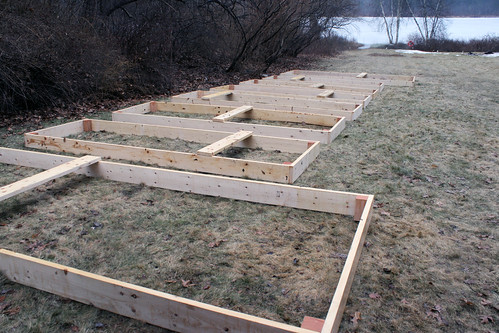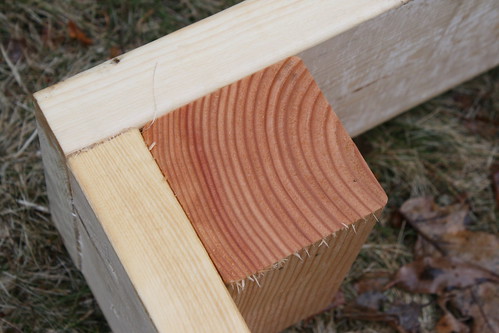 Yesterday my husband and I made eight raised beds for my new garden! Kind of a dreary late March day, but I am so happy seeing the beds all lined up! We made six 4x12 foot beds and two 6x15 foot beds.
Yesterday my husband and I made eight raised beds for my new garden! Kind of a dreary late March day, but I am so happy seeing the beds all lined up! We made six 4x12 foot beds and two 6x15 foot beds.
To make the six 4x12 beds:
- We started with fifteen 2x8x12's, untreated pine.
- We brought a compound miter saw down to the garden area. (It was raining off an on so we used a canopy to keep it dry.
- To make the 4' edges, four boards were cut in thirds.
- To make 24 corner brackets, two 4x4x8 untreated fir beams were cut the width of the boards, 7.5 inches.
- We butted up the boards one edge at a time and attached them using wood screws.
- We then placed the 4x4 bracket beam piece in the corner and used self-threading lumber screws to securely attach from both sides.
- Then we placed the beds where we wanted them. We're still looking at the placement and it may take us a few days to get the positioning we want.
- Next steps, we will level the beds with brick at one edge since we are on a bit of a slope. Then we'll secure the beds in place by pounding in wood stakes on the outside of the beds, every 3 feet. Then we'll add DIRT and plant stuff!




16 comments:
What do you have in the corners of those frames? The perpendicular boards seem to be at varying spacing - are they structural?
The perpendicular boards are not structural - they are just boards laid on the top of the frames. I use them to walk on, to give me a straight edge for rows, and to divide patches of vegetables.
I'll add a photo of the edges soon.
Its very cheerful to see new raised beds! Got my husband and son to build me 4 more a couple of weeks ago. Now the weather (down at the Jersey Shore) has turned much warmer and wetter (at least temporarily) I will be direct seeding and adding some pre-grown starts to these beds. I also was forced to replace the wire fence as it was more decorative than practical and the ground hog took advantage of that last summer!
O well, live and learn!
I know these beds are new but have you had issues in the past with not putting down landscaping fabric or some sort of barrier if you have existing grass?
You did a lot of work. I like the way you bracketed the beds.
Erin,
I haven't put down beds on grass before. What issues would I have?
Normally I would have removed the grass or at least turn it into the new soil, but the existing soil is so compacted that I don't plan to do either. Once healthy soil microbes and macrobes get going they will mix thing up and de-compact.
When we put raised beds on grass we lined the bottom with newspaper. This did a great job of keeping the weeds out for a long time.
Wow, so many beds! Can't wait to see them full of plants.
I have constructed 12 raised beds of similar dimensions over the past 5 years. At first I would completely remove the top layer of turf and double dig down 6-8 inches. After a while I started using the "lasagna method" where I would overlay several layers of newspaper and keep them soaked for several weeks before filling. For the last 4 I just dumped the fill dirt in over top of the grass. No difference whatsoever in terms of productivity, grass regrowth, etc. for the three methods. I recommend going simple.
Hi, Kathy,
It looks like that your new raised beds are close to the wood. Do you have deers in the area? If yes, how will you protect your vegetables from the deers? I have deers visiting my backyard almost daily and we don't have fences. So far, my husband just puts a few stakes and wraps my single raised bed with net. I would love to expand but haven't figured how to protect the beds from the deers without building fences. Thanks!
Hi. They look beautiful. Very exciting. May I make a suggestion. Have beds of similar size. Over the years, the middles will bulge if you do not put a support beam mid-center and bolt it through the sides in two spots...we retroactively did the work to our old beds, which are still bulging, somewhat, but were sure to make the change to the new ones. It's a lot of soil and water pushing up against two very long pine boards.
Anna
Thanks for your observations Jeff! Yeah simple! That's what I want to do.
Echo Wu,
Yes, we have deer. Lots.
I'm still planning my fence. Either a 5 foot metal fence or 4 foot fence with electric wire on top. But I've been told I should have a 6 foot fence.
I'm looking into nearby backyards to to see what others have.
You need a deer fence if you have deer in the area. They can eat a whole garden at once.
Hi! I am starting a new raised bed garden - it’s about the size of your backyard garden - and your blog is really inspiring! I am trying to decide whether cedar raised beds are worth the extra cost or not. After 5 years, how are your pine raised beds doing? Did you have to replace boards or beds? Thanks so much for sharing your work and experiences with us!
My pine raised beds last about 5-7 years.
In my community garden plot, pine beds my husband built in 2009, lasted until about 2015. I have not rebuilt them. I just raise the soil into beds with depressed paths between them. I prefer wood-lined raised beds, but this method is pretty easy and has the advantage that you can change the pattern of the beds if you want to.
Last year, at 4 years old, the beds he built in 2014 (in this picture) were as good as new. This year some corners have broken apart and the side is falling off. I think the wood is still intact enough to remake the corners. I think when these fall apart I will replace them.
I don't know how much longer cedar beds last. I work at Mass Hort, in the Gardens at Elm Bank in their vegetable garden. They recently remade their raised beds. They used white cedar. Lucky for them, the wood was hand milled and donated to them. I will ask how long their previous cedar beds lasted.
I also have to note that the Elm Bank vegetable garden only replaced half of their raised beds, the demonstration beds. For their production beds, they are now using the approach I described above, raising the soil for the beds, which are long 4 ft wide rows and walking paths are low and mulched with wood chips.
I'll look into costs and longevity of cedar versus pine a bit more and try to post on that.
Thank you so much, Kathy, for taking your time to answer my question and also for looking into the cedar beds. I’ve visited the garden at Elm Bank and it’s so pretty and tidy. I doubt mine will ever look as good! Thanks again Kathy!
Post a Comment